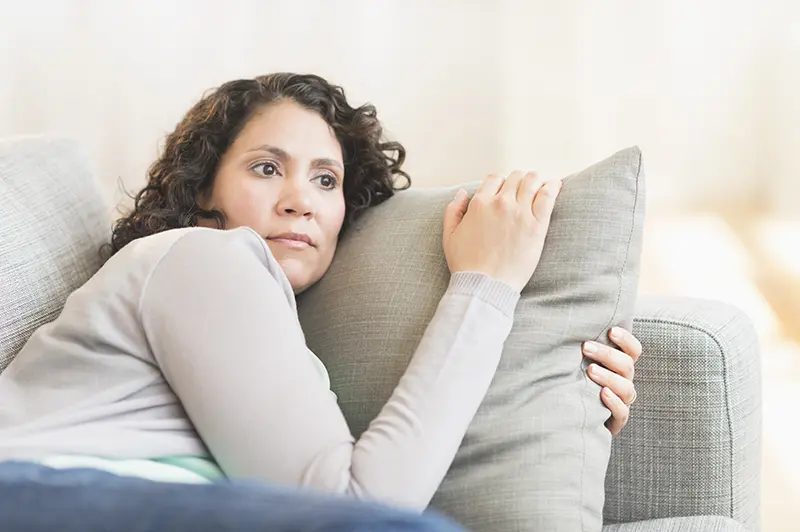Mental/Emotional Health

To take each day as it comes and stay upbeat and happy.
Female, 67, in response to what goals do you have with age
- 66% of adults 50-plus report excellent or very good mental well-being
- 58% of adults 50-plus report high resilience
- 45% of adults 50-plus report having felt anxious about things in the past 2 weeks
- 31% of adults 50-plus report having felt down, depressed or hopeless in the past 2 weeks
Source: Lampkin, Cheryl. Healthy Living: A look at how older adults are managing their emotional and mental well-being. An AARP Healthy Living Survey of adults ages 50 and older. Washington, DC: AARP Research, April 2022. Study fielded in February 2022.
Mental health, which encompasses emotional, psychological, and social health,1 is integral to overall well-being. Research shows that most older adults rate their mental health highly, and demonstrate resiliency by adapting to challenges, managing negative emotions, and developing an increased ability to cope. However, with age, one experiences and accumulates more stressful situations or life events such as loss of a loved one or financial problems, which can have an effect over the long term.2 Research also shows that many older adults experience mental health challenges, which can take form in a variety of ways, including stress, anxiety, and depression.3 Here, we discuss happiness, how older adults find the strength to bounce back from mental health challenges, as well as the types of mental health challenges they face. Topics related to this include:
More adults age 50-plus rate their emotional and mental well-being highly compared to physical health, and self-ratings of mental and emotional health steadily increase with age.
Percent rating aspects of health excellent or very good, among adults age 50-plus
Resilience
Most adults age 50-plus say they feel they have what it takes to bounce back, adapt to stressful events in life and thrive.
Nearly six in 10 (58%) adults age 50-plus rate their level of resiliency as high (8, 9, or 10 out of 10).4 Likewise, six in 10 (61%) adults age 50-plus say they tend to bounce back after hard times.5 Nearly 6 in 10 say it does not take them long to recover from a stressful event, and that they usually come through difficult times with little trouble. Adults are increasingly likely to rate their resiliency high with age. However, women are less likely than men to report bouncing back or recovering from stressful events quickly. Adults with lower income are also less likely than adults with higher income to report this. Hispanic adults are less likely than White and Black adults to say they recover quickly or come through difficult times with little trouble.
It is also important to note that revering resilience shown can be harmful, especially to certain groups like Black adults. For example, internalizing stereotypes like the “strong Black woman” may preclude Black women from identifying their mental health needs and seeking out any professional support or treatment.6
With age, adults age 50-plus are increasingly likely to rate their level of resilience highly.
Self-rating of resiliency, among adults age 50-plus
Most adults age 50-plus agree that they tend to bounce back quickly after hard times, that it does not take them long to recover from a stressful event, and that they usually come through difficult times with little trouble, however some differences emerge by segment.
Percent agreeing strongly or somewhat, among adults age 50-plus

Adults age 50-plus generally prefer to better manage their emotional and mental well-being through lifestyle habits (exercise, rest, healthy eating).
As adults ages 50-64 rate their mental health lower than adults 65 and older, they report a greater variety of ways they would like to better manage their emotional and mental health, including controlling stress.7
Black and Hispanic adults age 50 and older, who rate their emotional and mental well-being lower than White adults, show significant interest in wanting to incorporate actions to bolster their well-being. Black adults are significantly more likely than White adults to want to better manage their mental and emotional well-being by getting more rest, taking vitamins and talking to a mental health professional. Hispanic adults are more likely than White adults to be interested in practicing yoga/meditating. Although less common overall, both Black and Hispanic adults are more likely than White adults to be interested in going to the doctor more often, attending group meetings and participating in virtual social activities to better manage emotional and mental well-being.
Most older adults would like to better manage their emotional and mental well-being by getting more exercise, getting more rest, and eating a healthier diet.
Ways adults age 50-plus would like to better manage their emotional and mental well-being
Happiness

Happiness increases incrementally with age for adults age 50-plus.
Between ages 50-59, 18% of adults report being very happy.8 This increases to 21% between ages 60-69, 27% between ages 70-79, and 34% at age 80 or older. These findings corroborate the XM Institute’s 2021 US Consumer Survey, which show that happiness is highest among the oldest population (adults age 75-plus).9 Self-reports of being very happy also increase with higher household incomes.
Among adults age 50-plus, happiness grows with age.
Percent very happy and percent not too happy by age range
Mental Health Conditions
The share of adults reporting frequent poor mental health decreases with age.
Between 8% and 14% of adults age 50-plus report having frequent poor mental health (14+ days per month as defined by the Behavioral Risk Factor Surveillance System survey), whereas between 14% and 22% of adults ages 18-49 report having frequent poor mental health.16 The underlying reasons are likely various including theories behind increased resiliency and ability to cope with age as discussed earlier; but could also include selection bias if those in poor mental health are less likely to participate in studies in older age (if they have deceased, for example). Self-reported survey responses could also be impacted by stigmas around mental health.
While the youngest White adults ages 18-24 report the most frequent poor mental health days, the proportion of Black adults with frequent poor mental health days surpasses that of White adults at age 50. While Hispanic adults at younger ages report experiencing poor mental health days least frequently, after age 70 they exceed White and Black adults in indicating poor mental health. Regarding gender, men age 50-plus are less likely to report frequent poor mental health than women; however as they age, the gap between men and women narrows to virtually zero. Regarding household income, adults age 50-plus with higher household income are less likely to report frequent poor mental health as they age, compared to lower household income groups.
Adults age 50-plus are less likely than younger adults to report poor mental health.
Percent reporting frequent poor mental health days (14+ days per month)
However, it is common for adults age 50-plus to be bothered by anxiety.17
In 2022, nearly half (45%) of older adults age 50-plus said that they felt anxious about things recently, and over half (52%) said they had difficulty falling asleep or staying asleep.18 Moreover, most older adults age 50-plus (61%) said that they have experienced some level of anxiety in the past year.
Among adults age 50-plus, younger adults ages 50-64 are more likely to report signs of anxiety. Women and adults with lower incomes are more likely to report signs of anxiety as well.
Many adults age 50 and over report signs of anxiety.
Percent reporting the following signs of anxiety in the past two weeks

Feelings of depression are also not uncommon in adults age 50-plus.19
In 2022, a third (34%) of adults age 50-plus said they had little interest or pleasure in doing things recently, and nearly a third (31%) said they had feelings of depression or hopelessness.20
Younger adults ages 50-64 are more likely to report these signs of depression, compared to adults age 65-plus. Adults age 50-plus with lower income are also more likely to report signs of depression. Regarding gender, women age 50-plus are more likely to report signs of depression, 21 with studies suggesting that one possible explanation is women at all ages may ruminate as a way of coping with life challenges more than men.22
In 2022, around a third of adults age 50 and over reported little interest or pleasure in doing things, and feeling down, depressed, or hopeless in the past two weeks.
Percent reporting the following depression signs in the past two weeks, among adults age 50-plus
About a quarter of adults age 45 and older say they have been diagnosed with depression in their lifetime, and over one in ten say they currently have/are being treated for it.
Percent reporting having been diagnosed with depression in their lifetime and currently experiencing/being treated for it
Key Takeaways
-
Challenges may feel less insurmountable with age, as older adults overall express greater resilience in the face of hard times, self-report higher levels of happiness and less frequently report poor mental health days with age.
-
However, hurdles are felt across every stage of life, from universally experienced to age related. Older adults also report experiencing mental health issues including anxiety and feelings of depression, especially those ages 50-64.
-
Older adults are holistically engaged with their health, as many rate their mental and emotional well-being higher than their physical health.
-
Older Black and Hispanic adults report weaker mental and emotional well-being compared to older White adults. While they express a lower baseline level of well-being, they are more open to incorporating several tactics to manage their mental and emotional health. These include self-driven approaches like getting more rest, as well as seeking professional mental health support.
See also:
For more information related to mental and emotional health, see:
- The People Say : Mental Health Services
Sources
- Centers for Disease Control and Prevention (2023). About mental health.
- Mental Health Foundation (September 17, 2021). Stress.
- American Association for Geriatric Psychiatry. (October 27, 2022). Anxiety and older adults: Overcoming worry and fear.
- Lampkin, Cheryl. Healthy Living: A look at how older adults are managing their emotional and mental well-being. An AARP Healthy Living Survey of adults ages 50 and older. Washington, DC: AARP Research, April 2022.
- Lampkin, Cheryl. Healthy Living: A look at how older adults are managing their emotional and mental well-being, April 2022.
- Burnett-Zeigler, Inger. Nobody Knows the Trouble I’ve Seen: The Emotional Lives of Black Women, June 2021.
- Lampkin, Cheryl. Healthy Living: A look at how older adults are managing their emotional and mental well-being, April 2022.
- David, P & Levy, V. Second Half of Life Study. AARP Research, June 2022. Survey conducted in English.
- Temkin, B., Dorsey, M., & Quaadgras, T. (January 23, 2023). 2022 U.S. well-being fluctuates across age, gender, and ethnicity. XM Institute.
- Blanchflower, D. G., Graham, C., & Piper, A. (2023). Happiness and age – Resolving the debate. National Institute of Economic Review. 263, 76-93.
- Schwandt, H. (2016). Unmet aspirations as an explanation for the age U-shape in wellbeing. Journal of Economic Behavior and Organization, 122: 75-87.
- Shook, N. J., Ford, C., Strough, J., Delaney, D. B. (2017). In the moment of feeling good: Age differences in mindfulness and positive affect. Translational Issues in Psychological Science (pp. 1-25). American Psychological Association.
- Nakagawa, T., Gondo, Y., Ishioka, Y., & Masui, Y. (2017). Age, emotion regulation, and affect in adulthood: The mediating role of cognitive reappraisal. Japanese Psychological Research, 59(4): 301-308.
- Infurna, F. J., Gerstorf, D., & Lachman, M. E. (2021). Midlife in the 2020s: opportunities and challenges. American Psychologist, 75(4): 470-485.
- Galambos, N. L., Krahn, H. J., Johnson, M. D., & Lachman, M. E. (2020). The U-shape of happiness across the life course: Expanding the discussion. Perspect Psychol Sci. 15(4): 898-912.
- CDC. 2021 Behavioral Risk Factor Surveillance System (BRFSS).
- American Association for Geriatric Psychiatry. (October 27, 2022). Anxiety and older adults: Overcoming worry and fear.
- Lampkin, Cheryl. Healthy Living: A look at how older adults are managing their emotional and mental well-being, April 2022.
- National Institute on Aging. (2021). Depression and older adults. National Institutes of Health.
- Lampkin, Cheryl. Healthy Living: A look at how older adults are managing their emotional and mental well-being, April 2022.
- Lampkin, Cheryl. Healthy Living: A look at how older adults are managing their emotional and mental well-being, April 2022.
- Girgus, J. S., Yang, K., & Ferri, C. V. (2017). The gender difference in depression: are elderly women at greater risk for depression than elderly men? Geriatrics, 2(4): 35.
- National Council on Aging. (2022). How common is depression among older adults?
- Depression and Dementia | Alzheimer’s Society.
- Lavingia, R., Jones, K., Ashghar-Ali, A. A. (2020). A systematic review of barriers faced by older adults in seeking and accessing mental health care. Journal of Psychiatric Practice. 26(5): 367-382.